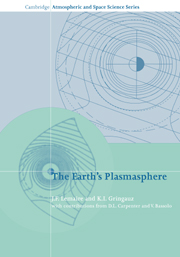Book contents
- Frontmatter
- Contents
- Preface
- Foreword
- Dedication
- Introduction
- Chapter 1 Discovery of the plasmasphere and initial studies of its properties
- Chapter 2 Electromagnetic sounding of the plasmasphere
- Chapter 3 Plasmasphere measurements from spacecraft
- Chapter 4 A global description of the plasmasphere
- Chapter 5 Theoretical aspects related to the plasmasphere
- Epilogue
- References
- Index
Chapter 5 - Theoretical aspects related to the plasmasphere
Published online by Cambridge University Press: 24 November 2009
- Frontmatter
- Contents
- Preface
- Foreword
- Dedication
- Introduction
- Chapter 1 Discovery of the plasmasphere and initial studies of its properties
- Chapter 2 Electromagnetic sounding of the plasmasphere
- Chapter 3 Plasmasphere measurements from spacecraft
- Chapter 4 A global description of the plasmasphere
- Chapter 5 Theoretical aspects related to the plasmasphere
- Epilogue
- References
- Index
Summary
Introduction
Thus far we have reviewed observations of the plasmasphere and its properties (Chapters 1, 2 and 3). In Chapter 4 an overall phenomenological description of these properties was attempted. It remains to review in this Chapter the main steps followed since 1960 in our theoretical description and understanding of the plasmasphere, of its connection to the topside ionosphere, and of its outer boundary, the plasmapause.
We start with one of the first theoretical problems encountered by the whistler community: what is the distribution of plasma along the geomagnetic-field-aligned filamentary plasma ducts within which VLF waves propagate? This question along with hydrodynamical and kinetic models of the plasmaspheric refilling mechanism will be discussed in the first part of this Chapter. In the second part we review the mechanisms of convection and of plasma interchange motion in a magnetic field. Following historical order, we examine the theories that have been proposed for the formation of the plasmapause and for the dynamics of cold plasma in the inner magnetosphere.
There are subsidiary or complementary theoretical aspects that will not be addressed in this Chapter, examples being questions of propagation and ray tracing of VLF waves in the plasmasphere and the theory of wave–particle interactions. Such interactions were mentioned in Chapter 4 as a potential mechanism for particle pitch angle scattering and for heating the outer plasmasphere; these important physical processes themselves would deserve an entire monograph.
The basic theoretical concepts and ideas which flourished during the past thirty years have been discussed in a number of contributed articles and review papers; we are not sure that we have properly quoted them all, and any omission must be taken as unintentional.
- Type
- Chapter
- Information
- The Earth's Plasmasphere , pp. 221 - 309Publisher: Cambridge University PressPrint publication year: 1998



